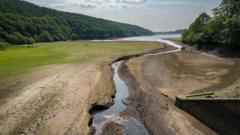Is a Drought Coming to Your Area? Find Out Now!

Understanding the Drought Crisis in the UK: A Comprehensive Overview
The UK is currently facing a significant drought crisis, particularly in north-west England and Yorkshire, as declared by the Environment Agency. This situation is not just a regional concern; it has implications that ripple across various aspects of our daily lives, from agriculture to water consumption. As dry weather prevails, understanding the causes and effects of drought is essential for all of us. This article aims to provide a detailed overview of the current drought conditions, their impact on different sectors, and the steps that may be necessary to address this growing challenge.
The Current State of Drought Across the UK
As we delve into the drought conditions impacting the UK, it is crucial to assess how various regions are faring. The Environment Agency's reports indicate that significant areas, particularly in the north-west and Yorkshire, are classified as experiencing drought. The effects are not isolated; other regions, such as eastern Scotland and parts of Wales, are also witnessing low water levels, creating a concerning pattern.
Defining Drought
Drought is a complex phenomenon that lacks a singular definition. In the UK, it is characterized by a prolonged period of below-average rainfall, leading to water scarcity. The situation has been exacerbated by the recent weather patterns, with March to May 2023 recorded as the sixth driest spring since 1836. This lack of moisture has severely impacted rivers, reservoirs, and underground water supplies.
Rainfall Trends and Reservoir Levels
In June 2023, while the UK experienced slightly above-average rainfall overall, significant disparities emerged. Regions like Northern Ireland, western Scotland, Wales, and south-west England saw wetter conditions, whereas central and eastern England and Scotland continued to suffer from dry weather. This inconsistency raises concerns about the long-term availability of water resources.
- By the end of May, river flows were below normal at approximately three-quarters of monitored sites across the UK.
- One in five sites recorded "exceptionally low" flow rates, indicating a troubling trend.
- Reservoirs in northern England, particularly in Yorkshire, were at their lowest combined levels in over 30 years.
These trends underline the critical need for monitoring and managing water resources efficiently. With long-term forecasts predicting continued dry conditions into July and possibly August, the risk of worsening drought conditions remains high.
Groundwater: The Hidden Resource
Groundwater is a vital but often overlooked component of the UK's water supply. It contributes significantly to water availability, particularly in south-east England. Unlike surface water, groundwater is stored beneath the surface in aquifers, where it can take years to replenish. This slow recharge makes groundwater an essential buffer during droughts.
The Role of Geology in Water Storage
The geological makeup of the UK significantly influences how water is stored underground. Some rock types are more efficient at storing and transmitting water than others. This variability means that regions with favorable geology can maintain more consistent water supplies, while others may struggle during drought conditions.
The Impact of Drought on Agriculture and Wildlife
The consequences of drought extend beyond water shortages; they deeply affect agriculture and wildlife. Farmers across the UK are grappling with the immediate impacts, including increased irrigation costs and concerns about future crop yields and livestock feed. The National Farmers' Union has voiced alarm over the potential for minimal harvests and diminished resources for livestock during winter months.
Challenges for Wildlife
The effects of drought are equally concerning for wildlife, particularly species dependent on wetland habitats. Organizations like the RSPB have highlighted the urgent need to ensure that vital wetland areas receive enough water to support bird populations and other wildlife. As drought conditions become more frequent, strategies to enhance habitat resilience to climate change are essential.
Climate Change: A Contributing Factor
Climate change plays a significant role in the increasing frequency and intensity of droughts. The Met Office anticipates that warmer temperatures will lead to drier summers in the UK, resulting in more rapid evaporation of moisture from soil, rivers, and reservoirs. Richard Allan, a climate science professor, notes that as the atmosphere warms, it becomes "thirstier" for moisture, exacerbating the onset of droughts.
Human Influence on Water Resources
While climate change is a crucial factor, human activities also significantly influence the availability of water resources. Water usage patterns, leakage rates from supply systems, and infrastructural limitations all contribute to the overall water management landscape. Measures such as implementing hosepipe bans and increasing the installation of smart meters may become necessary to control water demand effectively.
Government Initiatives and Future Planning
In response to the ongoing drought challenges, the UK government is planning several initiatives aimed at securing future water supplies. Among these initiatives are the construction of new reservoirs to enhance water storage capabilities. Current projects include:
- Building nine new reservoirs in England by 2050, in addition to one under construction at Havant Thicket in Hampshire.
- Collaborating with water companies in Scotland, Wales, and Northern Ireland to develop strategies for sustainable water management.
These proactive measures are essential to mitigate the impacts of future droughts and ensure a stable water supply for both residents and businesses.
Conclusion: Preparing for a Drier Future
The current drought crisis in the UK serves as a wake-up call for individuals, communities, and policymakers alike. Understanding the complexities of drought, its implications on agriculture and biodiversity, and the role of climate change is vital in preparing for a potentially drier future. As we navigate these challenges, it is crucial to adopt sustainable water practices, advocate for policies that prioritize water conservation, and remain vigilant in our efforts to protect this precious resource.
What proactive steps do you think individuals and communities can take to conserve water during drought conditions? #DroughtAwareness #WaterConservation #ClimateAction
FAQs
What are the main causes of drought in the UK?
Drought in the UK is primarily caused by prolonged periods of below-average rainfall, exacerbated by climate change and varying geological conditions that affect water storage.
How can drought affect agriculture?
Drought can lead to reduced crop yields, increased irrigation costs, and challenges in providing adequate feed for livestock, ultimately impacting food production and farmer livelihoods.
What steps can individuals take to conserve water during a drought?
Individuals can conserve water by reducing usage, fixing leaks, using water-efficient appliances, and being mindful of water consumption during daily activities.
How do groundwater levels affect drought conditions?
Groundwater serves as a critical buffer during droughts, but if it is not replenished due to low rainfall, it can exacerbate water scarcity in regions relying heavily on this resource.
Published: 2025-07-01 23:12:13 | Category: technology



